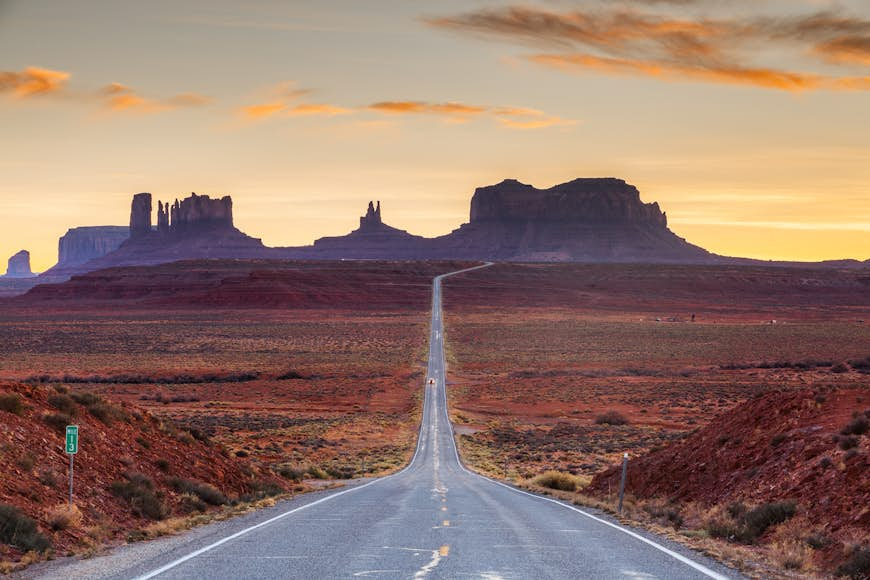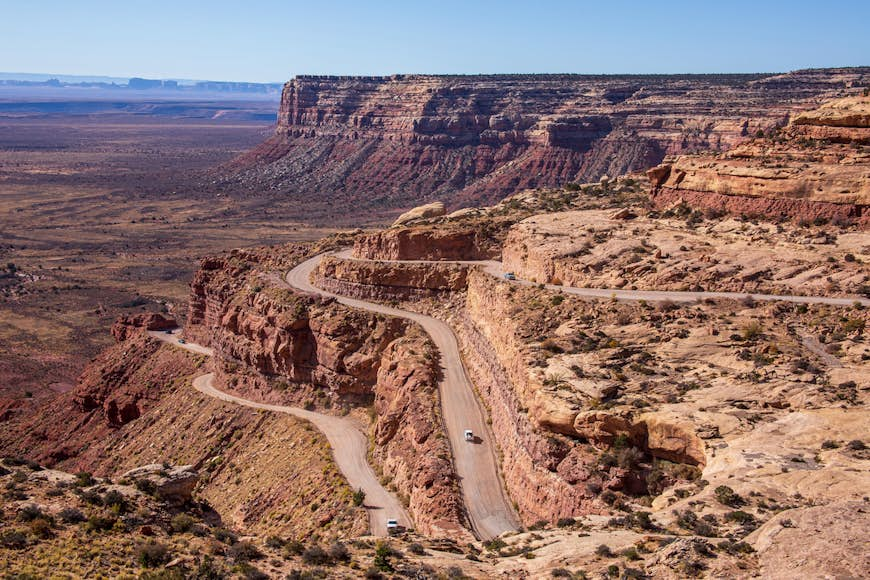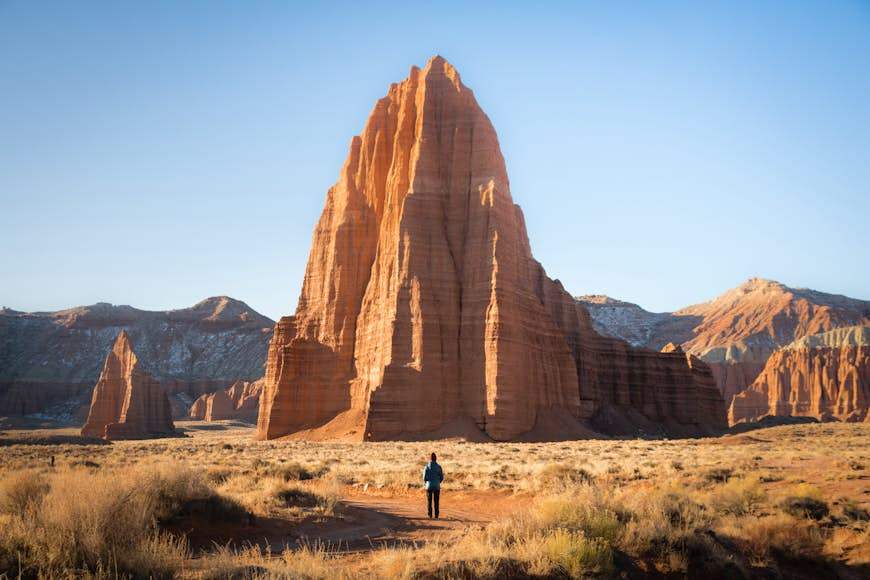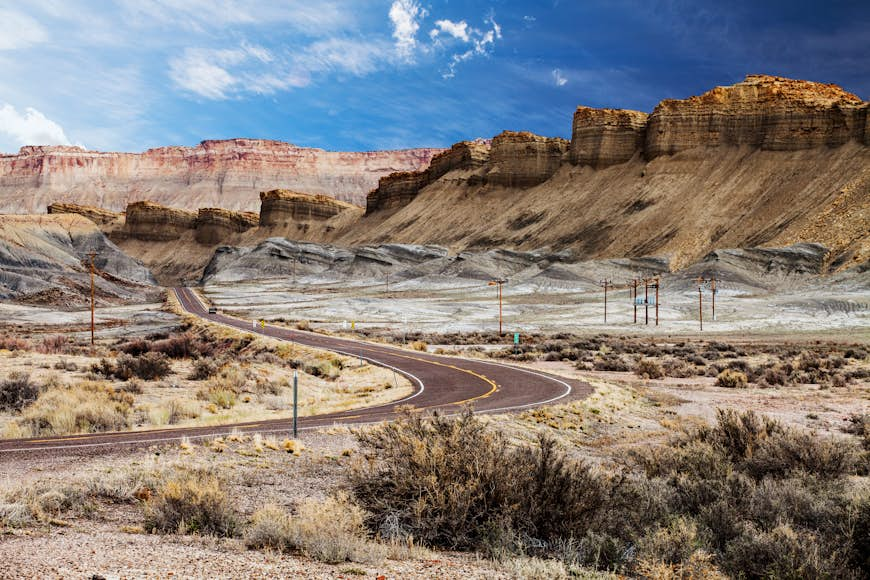Utah is world famous for its red-rock arches and deep canyons – and as with many things in life, the journey across the Beehive State adds up to much more than any singular landmark.
Since you’ll be driving through one of America’s most beautiful states, you can expect jaw-dropping views. Thankfully, many of these vistas can be accessed through paved highways, scenic drives and roadside viewpoints. While most of Utah’s best road trips are easily accessible by car, some require at least all-wheel-drive crossovers or high-clearance 4×4 vehicles.
To really get to know this state, fuel up, roll down the windows and hit the road. Here are the best road trips in Utah.
The essential Utah road trip is Scenic Byway 12
Panguitch to Torrey; 122 miles; half a day
If you take only one road trip in Utah, make it this one. Along this route, you can experience much of what the state is famous for in a single afternoon.
Highlights include two red-rock tunnels, Dixie National Forest and its nearly two million acres of pinyon pine and desert landscapes, a summit overlook from 9000ft, and nearby access to four of Utah’s greatest natural treasures: Zion, Bryce, Grand Staircase and Capitol Reef National Parks.
With plenty of shops and stops along the way, you can easily make a day of it – or even a couple weeks of if you stop off to thoroughly explore the parks.
Get Jurassic on the Dinosaur Diamond Prehistoric Hwy
Starting and ending in Vernal; 512 miles; 1–3 days
Millions of years ago, Utah was part of a coastal floodplain that was rich in flora and fauna. Evidence of those animals comes in the form of footprints and fossils buried in the state’s desert cliffs and rocky outcroppings, traces visitors can seek out today.
To see it all, there’s no better route than the Dinosaur Diamond Prehistoric Hwy. Starting and ending in the beautiful town of Vernal, this epic route travels in a diamond shape through Utah and a little of Colorado along I-70, US 6, US 40, and US 191, among others.
Highlights include the fossil quarry at Dinosaur National Monument, Flaming Gorge, Jones Hole, Fantasy Canyon, and Canyonlands and Arches National Parks in Moab.

You’ll have a Hollywood backdrop along Monument Valley Hwy 163
Mexican Hat to Monument Valley; 45 miles; half a day
Dozens of big movies, including one Academy Award winner, have been shot in Monument Valley. Arguably the greatest backdrop in cinematic history, this road trip will leave you feeling like a character in Stagecoach.
For the most impressive views, travel south from Mexican Hat, take pictures of the sombrero-shaped rock and “Forrest Gump Point” then drop into Monument Valley for even more surreal photography.
While you can easily complete the route in under two hours, you’ll want to plan extra time for side trips and connecting byways such as Hwy 276.
Head over the mountains on the Mirror Lake Scenic Hwy
Kamas to the border of Wyoming; 42 miles; half a day
Less than two hours from Salt Lake City, Mirror Lake Hwy is one of the most popular mountain driving routes in the state. Heading east from Kamas, the paved drive takes you through the High Uinta Wilderness, one of the state’s best-kept secrets.
Highlights include Upper Provo Falls, the photogenic Mirror Lake, Bald Mountain Pass, Christmas Meadows trailhead, as well as numerous overlooks, picnic areas and campsites along the way. It’s also the ideal place to experience fall foliage.
Hit the road to hit all of Utah’s “Mighty 5”
Arches National Park to Zion National Park; 1040 miles; 10 days
Nowhere else in the country – if not the world – will you find a higher concentration of national parks than in Southern Utah. And this ultimate route will get you to them all – and then some.
Starting in Moab at Arches National Park, the route works its way east through Canyonlands, Capitol Reef, Bryce and Zion. Since there’s no direct way to do all this, however, it makes more sense to stop at other parks along the way, including Monument Valley, Goblin Valley and Kodachrome Basin. Whatever way you make the trip, you can look forward to the full scope of Utah’s natural wonders.
Introducing Utah’s national parks

Expect stunning views – and white-knuckle curves – along Moki Dugway
Mexican Hat to Natural Bridges National Monument; 34 miles; half a day
This might be one of the most white-knuckle car rides in America. With hairpin turns and an elevation gain of over 1000ft, this graded dirt road is best driven north toward Natural Bridges National Monument.
You can look forward to truly exceptional vistas. While at the top, take a detour west to see stunning Muley Point, which overlooks the deep canyons of the San Juan River. Other highlights include an overlook of Valley of the Gods and its stunning buttes and stone pinnacles. If not traveling to Natural Bridges, this is also a wonderful out and back drive by car.
Follow the switchbacks from Potash to White Rim Rd
Moab to Island in the Sky Visitor’s Center; 32 miles; half a day
If you thought Moki Dugway was treacherous, wait till you drive this one. To save the best for last, drive north from Moab on Hwy 191, then turn south on Hwy 279 to snake around the Colorado River, Corona Arch and nearby rock-climbing cliffs and petroglyphs.
From there, turn west onto Potash Rd to make your way through Dead Horse Point and into Canyonlands National Park before finally ascending the towering Shafer Trail switchbacks to the Island in the Sky Visitor’s Center.
Although some cars are capable of this dirt drive, you’ll want at least an all-wheel-drive vehicle with higher-than-normal clearance. If in doubt about your vehicle’s capability, you can always go back the way you came.

Hop in a 4×4 to take the Cathedral Valley Scenic Backway
Cathedral Road to Hartnet Road; 72 miles (with detours); half a day
To see the half of Capitol Reef National Park that few people ever visit (and it’s the better half), you’ll need a 4×4 vehicle with high clearance. The reward is significant: castle-like sandstone formations, panoramic desert views and (usually) not another person in sight.
The region’s unique features were formed over millions of years of erosion, leaving behind sculpted monoliths striated with the layers of time. For the full experience, get a permit and camp out under the starry skies. Full route details can be found here.
